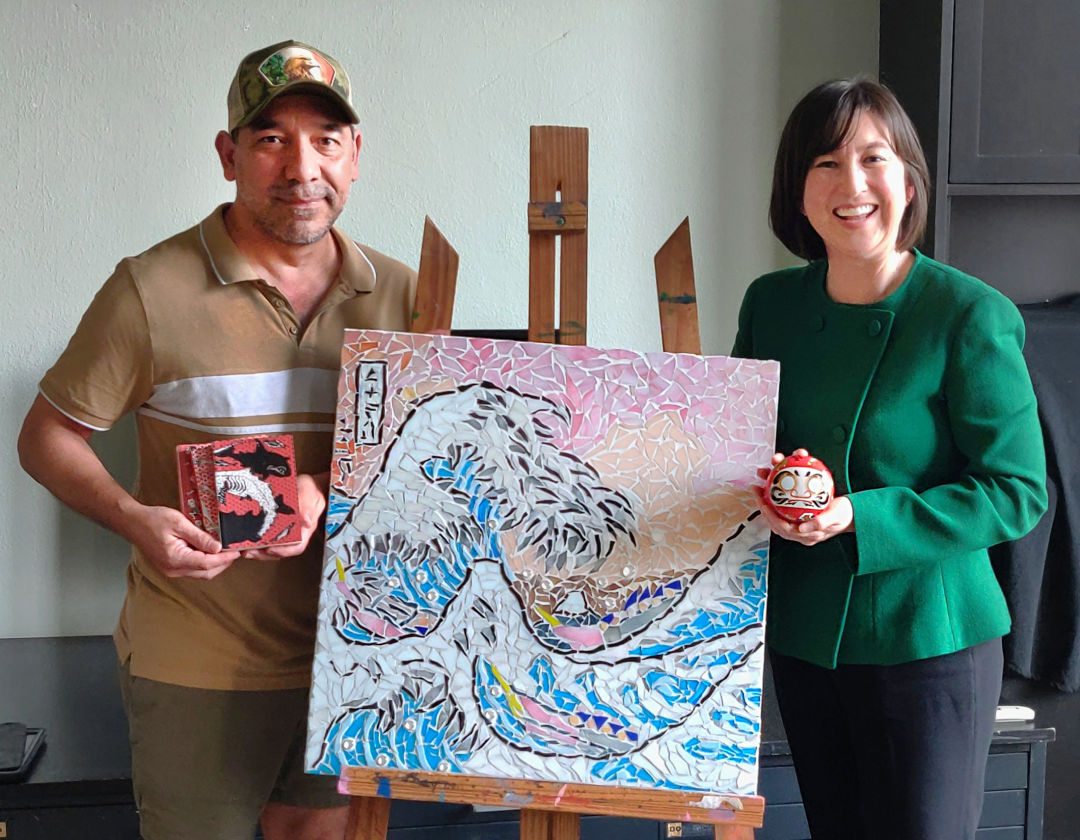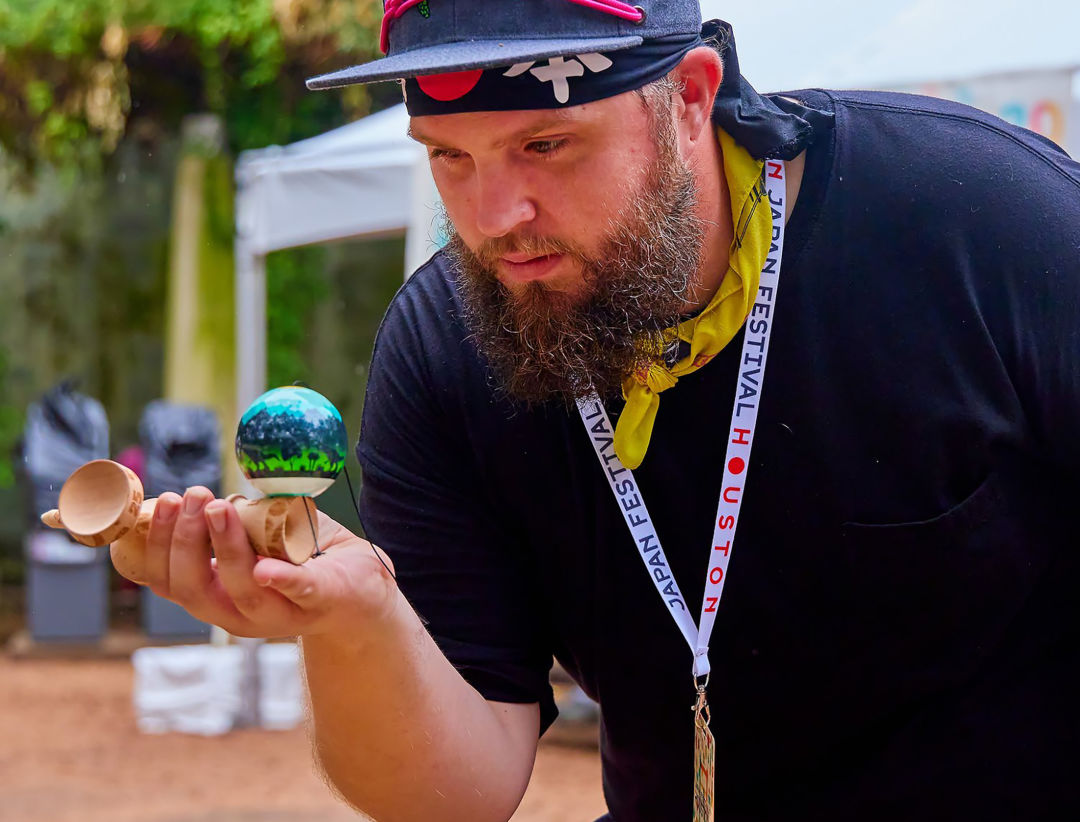Julio Luna educating a baby printmaking on the annual Japan Competition.
Viet-Cajun. Ukrainian-Canadian. Chinese language-Puerto Rican. Mex every part. Houston’s meals scene is characterised by wealthy cultural hybridization, however the melding and merging of concepts and aesthetics and geographies extends properly past the plate. MECA, the nonprofit bringing Latin American artwork and tradition to underserved communities, and the Japan-America Society of Houston share a inventive relationship that has resulted in fairly Houstony outcomes.
“Multiculturalism is necessary, and bringing that again to our work, for me, is essential. I believe that’s how we will proceed and thrive,” says Armando Silva, govt director of MECA. “The great thing about all of this collaboration is precisely that: celebrating the multiculturalism that’s in our metropolis.”
Michael Martin, a former MECA intern who now serves as a educating artist with the nonprofit, is credited as first bringing the 2 organizations collectively. Whereas engaged on his humanities diploma with minors in visible artwork and philosophy at College of Houston Downtown, Martin grew to become fascinated with kendama, a Japanese ball-and-cup recreation with a world following and quite a few organizations and competitions testing gamers’ mettle.
“I’d by no means actually thought kendama was going to turn out to be such a critical, huge a part of my inventive expression, however through the years it simply sort of organically occurred,” Martin says.
Kendama, and subsequently Japanese visible artwork, first got here to MECA when Martin labored on the group’s summer season camps. When he was entertaining campers throughout dismissal, whereas they waited for his or her dad and mom or guardians to select them up, the youngsters observed him sporting his kendama like a necklace.
“I’d let one or two youngsters attempt, and I noticed there was a line of youngsters on the finish of the day ready to play with this one kendama. And so I made a decision to deliver a pair extra,” Martin says. “And it sort of simply changed into this particular factor that children would do on the finish of the day.”
Martin has since achieved licensed kendama sensei honors by way of the Japan Kendama Affiliation, and he often attends the annual Japan Competition to reveal the recreation to onlookers and encourage them to provide it a shot. Alongside this private progress got here a chance to interpret the Japanese recreation via a Latin American lens.
The Mexican stick-and-ball recreation balero and kendama aren’t precise parallels: Kendama has a two-headed hammer form providing two completely different choices for the place the ball would possibly land. Balero has just one, which resembles a barrel with an indentation on the highest for catching the ball. As Martin started introducing the kendama to MECA campers and Japan Competition attendees, he observed that many youngsters from MECA would play the Japanese recreation utilizing Mexican guidelines and methods. A few of the youngsters who struggled with the kendama improved their efficiency once they began enjoying utilizing balero guidelines. Among the many youngsters enrolled on this playful summer season camp, a inventive melding of artwork and tradition emerged organically. The youngsters would go house to their dad and mom and share with them the brand new methods of seeing and enjoying with the baleros they stored at house.
Martin first met printmaker Julio Luna by way of MECA. They each labored on the summer season camp in 2023, which concerned a partnership with JASH and was themed round introducing youngsters to Japanese tradition. By then, Martin was additionally working as an artwork teacher on the camp, and Silva credit him with bringing the 2 organizations collectively for the summer season camp collaboration. He and Luna bonded over their shared love of ukiyo-e artist Katsushika Hokusai (whose iconic print The Nice Wave off Kanagawa is recognizable to folks even with little curiosity in artwork). They taught the campers find out how to make woodblock prints the way in which Hokusai would have. Martin made a mosaic—a typical medium in Latin America—of The Nice Wave.

Armando Silva (left) and Patsy Brown (proper) with Michael Martin’s mosaic of The Nice Wave off Kanagawa.
Even outdoors of a camp context, Martin and Luna started exploring their very own visible arts voices with the assist of MECA and JASH. They discovered some commonalities within the Mexican and Japanese inventive traditions, resembling a wealthy historical past of printmaking, and located inspiration in constructing bridges between the variations.
“In Japan, a number of occasions, they reduce their colours. That’s one thing that I’ve executed with my palette quite a bit in a number of my drawings and work. I’ll go monochromatic, or I’ll simply use the first colours and secondary colours,” Martin says. “And I’ve positively explored a number of ink stuff. The look of the black ink on the white paper is akin to the printmaking type, you already know, the place every part is sort of destructive and constructive house.”
A few of Luna’s works additionally present this interaction between Mexican and Japanese artwork kinds. One among his prints depicts maneki-neko, the acquainted waving cat that smiles at you from restaurant counters, as a daruma doll, spherical Zen Buddhist figures depicting a monk with no pupils, one to be stuffed in whereas making a want and the opposite as soon as the want has been granted. It’s black-and-white, evoking the monochromatic aesthetic Martin cites. However in its geometry, the advanced, curvilinear shapes evoke historical Mayan and Aztec artistry.
Martin continues to work with taking Japanese topics—just like the legendary tengu, a prideful humanoid spirit usually depicted with shiny pink pores and skin, a comically lengthy nostril, and wings—and immortalizing them in mosaics impressed by José Fuster, whose work he studied whereas touring via Cuba. And the flipside as properly: Skulls don’t seem usually in Japanese artwork, particularly when in comparison with Latin American, however Martin will create works with them utilizing a extra Japanese-style minimalist method to element.
It’s new stuff, and so very Houston, nevertheless it’s additionally…properly…not. Although the results of unbiased inquiry and experimentation, Luna, Martin, and the campers gravitating towards discovering their very own multicultural voices have parallels in long-term geopolitical relationships.
“Japan and Mexico have an extended historical past of collaboration and assist. I imagine the partnership between the 2 nations goes again over 400 years,” says Patsy Brown, govt director of JASH. “I imagine simply final 12 months, Mexico and Japan marked their four-hundredth anniversary of being primarily strategic world companions.”
There have been some challenges alongside the way in which for the native teams. Silva notes that the daruma dolls induced some confusion amongst campers’ dad and mom. They expressed a fear that the ritual might run counter to the religions practiced in their very own properties. However with extra clarification and publicity, they got here to embrace the Japanese custom.
“The daruma doll, it did open up these areas of thought for some…understanding that our neighborhood actually needs to be taught and have interaction in different cultures,” Silva says. “This chance opened up different avenues. They noticed various things; they skilled completely different folks.”
To encourage extra interactions between Japanese and Latin American cultures, JASH at all times sponsors a sales space at MECA’s annual Día de Muertos celebration. Luna and Martin additionally arrange on the Japan Competition, utilizing each occasions as alternatives to show guests about printmaking, kendama, and the opposite inventive fusions they’ve explored alongside the way in which. The 2 have additionally visited NASA, the Daikin air conditioner manufacturing unit, and the native Tanabata Star Festivals as ambassadors of this melting pot.

Michael Martin’s ardour for kendama helped set up a connection between MECA and JASH.
“We hope to proceed to seek out methods to work with MECA, to exit into the neighborhood,” Brown says. “Hopefully, we’ll discover different methods to actually showcase the Japan and Mexico ties on a extra formal stage transferring ahead.”
MECA can be engaged on creating new connections with Houston-area cultural organizations that will probably nurture extra inventive fusions. They’re planning a collaboration with Silambam Houston, a classical Indian dance troupe and faculty, in addition to the Indo-American Affiliation, which promotes Indian performing arts, primarily music. Riyaaz Qawwali, an ensemble performing Sufi devotional music originating from throughout South Asia, can be slated to participate in the summertime camp.
“I believe that’s the right instance of what Houston is, in our variety, proper?” Brown says. “The objective of actually making an attempt to broaden horizons via varied connections in varied communities.”

